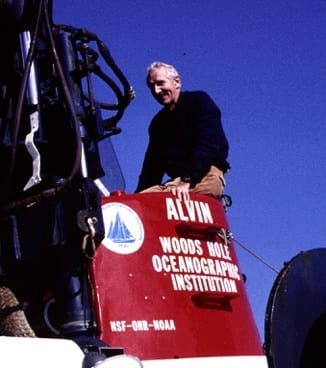Richard P. Von Herzen
Richard P. Von Herzen, an earth scientist who pioneered studies of heat flowing from the seafloor, died Thursday morning at the age of 85 in Portola Valley, Calif. The cause was vascular disease, said his daughter, Lane Von Herzen.
During his 50-year career at Woods Hole Oceanographic Institution (WHOI) starting in the late 1950s, Von Herzen developed the first modern instruments and techniques to make previously unattainable measurements of heat emanating through the seafloor from Earth’s interior. He spearheaded pioneering voyages in the 1960s across the south Atlantic and the Pacific Ocean, in which he revealed high heat flow at volcanic seafloor mountain ranges, called mid-ocean ridges, and much lower heat flow at ocean trenches.
This heat flow data provided corroborating evidence for the heat engine that drives plate tectonics: Magma rising from the mantle at mid-ocean ridges solidifies to create new seafloor. As young seafloor spreads out from the ridges, it gradually cools until it becomes dense enough to sink back and be recycled into the mantle, some 200 million years after it was born. At the time, plate tectonics was just a theory; now it is a foundation of earth science that explains earthquakes, volcanoes, mountains, oceans, and many other important characteristics of our planet.
Tracking his heat-flow discoveries, Von Herzen was part of the team that discovered Jules-Verne-like warm-water plumes at the Galápagos Rise in 1972. In 1977, Von Herzen and colleagues mounted an expedition to explore this phenomenon, employing remote-controlled submersibles with cameras to find out what was occurring kilometers below the ocean surface. They found that molten rocks heated up seawater that drained into seafloor cracks, making it more buoyant. The superheated, mineral-rich water gushed in geyser-like formations on the seafloor called hydrothermal vents.
Quite unexpectedly, they also made one of the most profound scientific discoveries of the 20th century: These vent fluids nourished lush, never-seen-before communities of animals, including large clams and huge red-tipped tubeworms. They thrived without light at high-pressure depths by extracting energy from chemicals, rather than solar energy from the sun—chemosynthesis instead of photosynthesis. The fantastic nature of these strange seafloor organisms expanded scientists’ knowledge of the potential for life to exist in extreme environments that were previously assumed to be barren—on Earth and elsewhere in the universe.
Dr. Von Herzen earned his B.S. in geophysics at the California Institute of Technology in 1952, his M.A. in geological sciences at Harvard in 1956, and his Ph.D. in marine geophysics at Scripps Institution of Oceanography in 1960. He served in the U.S. Army between 1953 and 1955. Except for a brief diversion as deputy director of the Office of Oceanography UNESCO in Paris, he devoted his 50-year-plus research career at WHOI to the fundamental understanding of geothermal processes in the ocean basins. He wrote hundreds of scientific papers and was elected Fellow of the American Geophysical Union (AGU) in 1986.
For his pioneering research, Von Herzen was awarded the AGU’s prestigious Maurice Ewing Medal in 1998. “Dick has virtually established marine heat flow as a discipline within marine geophysics,” said Seiya Uyeda of Tokyo’s Tokai University in Von Herzen’s award citation. “Dick … has made many great contributions to the understanding of Earth’s thermal structure and to the technology needed for doing heat flow research.”
Von Herzen continually developed new instrumentation that revolutionized marine heat flow research. With a colleague, he invented the now standard needle probe method for sediment thermal conductivity measurements. Probably his greatest invention was digital recording and telemetering for the multiple penetration heat flow probe. Other instrumental innovations included thermal measuring devices for the deep submersible Alvin and deep-sea ocean drilling and techniques to make marine geothermal measurements with an autonomous underwater vehicle. Many of the devices and techniques pioneered by Von Herzen are now standards within oceanography studies worldwide.
“Dick Von Herzen will go down as one of the most influential, respected, and well-liked marine geothermal scientists ever,” said Keir Becker, a marine geoscientist at the University of Miami’s Rosenstiel School of Marine & Atmospheric Science.
“He was the giant of his field,” said Peter Molnar, geologist at the University of Colorado. “He did it all: built the equipment, improved the equipment, took it to sea, made the measurements, interpreted them, and put it all in context rooted on a firm theoretical footing. Moreover, he was a paragon of composure.”
Von Herzen took great pleasure in advising graduate students from MIT and other institutions, mentoring many who went on to become leading scientists in their own right.
“The entire marine community holds him in the highest regard, as evidenced by the awards he has received from his peers and the large variety of coauthors he has had over the years,” said Marcia McNutt, geophysicist, former director of the U.S. Geological Survey, and now editor-in-chief of the scientific journal Science.
Von Herzen was predeceased by his wife of 54 years, Jan Von Herzen, in 2012. In addition to his daughter, Lane, and her husband Ken MacWilliams of Portola Valley, CA, he is survived by his son Brian Von Herzen and his life-partner Rebecca Truman of Carson Valley, NV and Woods Hole, Mass; two grandsons, Graham MacWilliams and Duncan MacWilliams; three brothers, Norman Von Herzen, Michael Herzen and Jim Von Herzen; and one sister, Joyce Balak. His brother, Bruce Von Herzen, died in 2000.
According to his daughter, he asked that his oceanographic colleagues scatter his ashes over the Marianas Trench, the deepest part of the ocean.
A memorial service will be held at the Church of the Messiah, 22 Church Street, Woods Hole, on Friday, June 17, at 2:00 p.m. A reception will follow at 3:00 p.m. in Fisher House next door.

